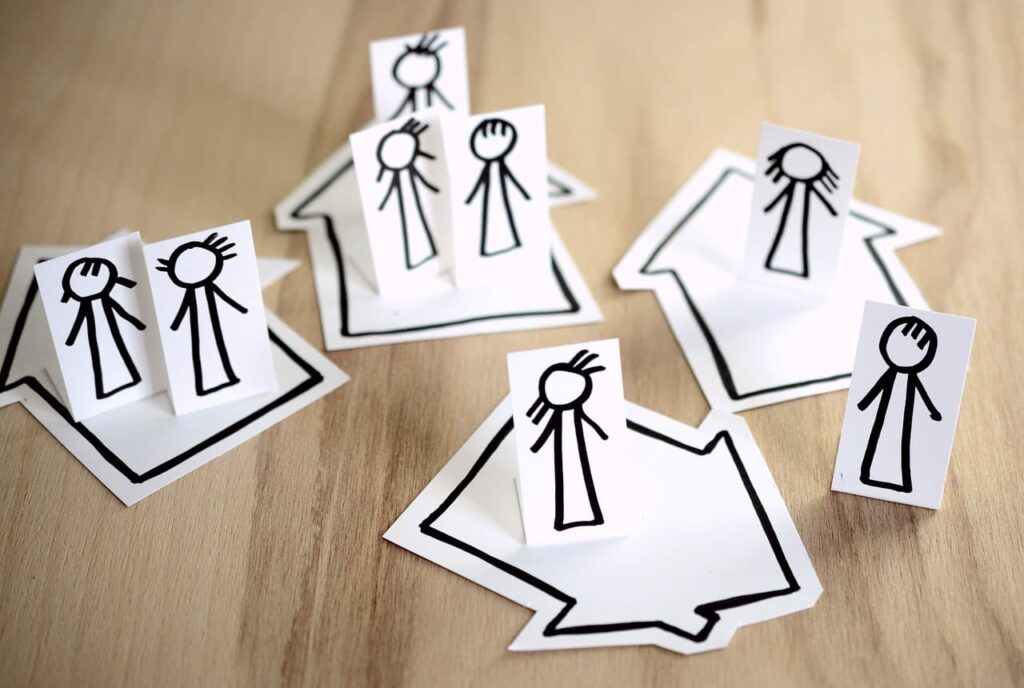[Photo Credit] Pixabay
TL;DR — Korean family titles map relationships, not just people.
This guide explains how Koreans label relatives by generation, side (paternal vs. maternal), and marriage ties—and how those titles shift in modern life and dramas.
You’ll learn core terms for parents and siblings (e.g., 오빠/언니/형/누나/동생), how paternal (친가) vs. maternal (외가) titles differ (고모 vs. 이모, etc.), and what to call in-laws after marriage (시어머니/시아버지, 장모님/장인어른, 도련님, 형님, 동서).
We also highlight what’s changing—many families now prefer first names or simpler honorifics—and give practical tips so you can follow K-dramas and real-life conversations with confidence.
1. Korean Family Titles
Family terms in Korean go beyond simple words; they reflect relationships and generations, clearly understanding who is who within a family. This unique cultural aspect of the Korean language plays a crucial role in shaping Koreans’ identity.
Have you ever wondered about the family terms used in Korean dramas? This post will help you familiarize yourself with these titles and enhance your experience by instantly recognizing them while watching.
2. Basic Family Titles
Parents
l 아버지 (Father): The title for the head of the family. A more casual term is 아빠 (Dad).
l 어머니 (Mother): The central figure in the family. Casually referred to as 엄마 (Mom).
Siblings
l 형 (Hyeong): What a male calls his older brother.
l 누나 (Noona): What a male calls his older sister.
l 오빠 (Oppa): What a female calls her older brother.
l 언니 (Eonni): What a female calls her older sister.
l 동생 (Dongsaeng): A gender-neutral term for younger siblings. For specificity:
Ø 남동생 (Namdongsaeng): Younger brother.
Ø 여동생 (Yeodongsaeng): Younger sister.
Unlike terms for older siblings, 동생 titles depend on the younger sibling’s gender, not the speaker’s.
When Siblings Are Married
l 형수 (Hyeongsu): The wife of one’s older brother (used by younger males).
l 매형 (Maehyeong): The husband of one’s older sister (used by younger males).
l 올케 (Olke): The wife of one’s older brother (used by younger females).
l 형부 (Hyeongbu): The husband of one’s older sister (used by younger females).
l 제수씨 (Jesussi): The wife of one’s younger brother.
l 매제 (Maeje): The husband of one’s younger sister.
3. Distinction Between Paternal and Maternal Relatives
In Korean, specific terms clearly distinguish paternal relatives (친가) and maternal relatives (외가).
Paternal Relatives (친가)
l 할아버지 (Hal-abeoji): Father’s father.
l 할머니 (Halmeoni): Father’s mother.
l 큰아버지 (Keun-abeoji) / 작은아버지 (Jageun-abeoji): Father’s older brother / younger brother.
l 큰어머니 (Keun-eomeoni) / 작은어머니 (Jageun-eomeoni): The wife of father’s older brother / younger brother.
l 고모 (Gomo): Father’s sister (older or younger).
l 고모부 (Gomobu): The husband of father’s sister.
Maternal Relatives (외가)
l 외할아버지 (Wae-hal-abeoji): Mother’s father.
l 외할머니 (Wae-halmeoni): Mother’s mother.
l 외삼촌 (Wae-samchon): Mother’s brother.
l 외숙모 (Wae-sukmo): The wife of the mother’s brother.
l 이모 (Imo): Mother’s sister.
l 이모부 (Imobu): The husband of the mother’s sister.
These specific terms identify the relationship and reflect Korea’s strong emphasis on familial structure and lineage.
4. Family Titles After Marriage
After marriage, additional terms are used to address one’s spouse’s family. These titles carefully reflect age, relationship, and hierarchy within the family.
Husband’s Family (시댁)
l 시어머니 (Si-eomeoni), 시아버지 (Si-abeoji): Husband’s mother and father.
l 아주버니 (Ajubeoni): Husband’s older brother.
l 형님 (Hyeongnim): The wife of the husband’s older brother.
l 도련님 (Doryeonnim), 서방님 (Seobangnim): Husband’s unmarried younger brother / married younger brother.
l 시누이 (Sinu-i): Husband’s sister (older or younger).
l 시매부 (Simaebu): The husband of the husband’s sister.
l 동서 (Dongseo): The spouse of the husband’s sibling.
l 시조카 (Si-joka): The child of the husband’s siblings.
Wife’s Family (처가)
l 장인어른 (Jangin-eoreun): Wife’s father.
l 장모님 (Jangmo-nim): Wife’s mother.
l 처남 (Cheonam), 처제 (Cheoje): Wife’s younger brother / younger sister.
l 처형 (Cheohyeong): Wife’s older sister.
l 처남댁 (Cheonamdaek): The wife of the wife’s younger brother.
l 처조카 (Cheo-joka): The child of the wife’s siblings.
These terms highlight Korea’s cultural emphasis on the intricate dynamics of familial relationships.
5. Changes Across Eras and Generations
In the past, family titles were governed by strict hierarchies influenced by traditional Confucian culture. However, modern trends have simplified these terms.
For instance:
l In the past, it was common to address the husband’s younger brother as 도련님 (Doryeonnim) and his younger sister as 아가씨 (Agassi). Nowadays, people are encouraged to use first names instead.
l Similarly, addressing the wife’s older brother as 형님 (Hyeongnim) has shifted to the more direct term 처남 (Cheonam) in many cases.
These changes contribute to smoother communication and help maintain more equal family relationships. Nonetheless, traditional terms are still widely used, so it is essential to choose the appropriate title based on the situation.
❓ FAQ (Frequently Asked Questions)
Q1. Why do Koreans split aunts/uncles by “mom’s side” vs “dad’s side”?
Because kinship terms encode lineage. On dad’s side, you’ll hear 고모 (paternal aunt) and 고모부 (her husband), while on mom’s side, it’s 이모 (maternal aunt) and 이모부 (her husband). Uncles differ too: 외삼촌/외숙모 on mom’s side, vs. 큰아버지/작은아버지 (father’s older/younger married brothers) on dad’s side. This paternal–maternal split is standard in Korean. (Wiktionary)
Q2. What’s the difference between 오빠/언니 and 형/누나?
It’s about the speaker’s gender, not just the listener’s age. A female calls an older male 오빠 and an older female 언니. A male calls an older male 형 and an older female 누나. These are common address terms among friends, too.
Q3. When do I add the honorific “-님” (-nim) to family titles?
Use -님 to raise politeness, especially for in-laws or someone else’s family: 어머님/아버님, 할머님/할아버님, 형님. This fits Korean “pronoun avoidance,” where kinship titles replace “you.” (Wikipedia)
Q4. Are “도련님” and “아가씨” still used for in-laws like in dramas?
They’re understood (and you’ll hear them in historical/chaebol dramas), but many modern families prefer names or simpler terms (e.g., 시동생, 형/누나, or just the person’s name + 님). Usage varies by family. (Reddit)
Q5. Quick cheat sheet: what do spouses call in-laws?
– Wife → husband’s family: 시아버지/시어머니, (husband’s) older brother 아주버님, his wife 형님, younger brother 도련님 (unmarried)/서방님 (married), husband’s sister 시누이, sister’s husband 시매부, same-generation in-law 동서.
– Husband → wife’s family: 장인어른/장모님, wife’s older sister 처형, her husband 매형, younger brother 처남 (his wife 처남댁), younger sister 처제, her husband 제부.
Q6. In everyday life, can I call non-relatives “언니/형/이모/사장님”?
Yes—Koreans often extend kinship/professional titles to strangers (e.g., 사장님 to staff). Safest catch-all in shops/restaurants is 저기요 (“excuse me”). Avoid addressing women you don’t know as 아줌마; it can offend. (Reddit, Wikipedia)
Q7. Why do kids call a friendly older woman “이모”?
It’s a polite fiction: 이모 signals “mother ‘s-generation woman I’m close to.” It marks respect and warmth, even without blood relation. (Reddit)
Q8. Are there special words for paternal vs. maternal grandparents?
Yes: 할아버지/할머니 for paternal; add 외- for maternal (외할아버지/외할머니). The 외- prefix flags “maternal side.” (Wiktionary)
Q9. How are titles changing across generations?
You’ll still hear traditional in-law terms, but many families now simplify—using first names plus -님 or neutral kinship titles—to reduce hierarchy and awkwardness. Practices vary by family and region, so ask what they prefer.
Q10. What should LGBTQ+ spouses use for in-laws?
There’s no single standard; couples often mirror the side of the family rather than the speaker’s gender (e.g., using 장모님/장인어른 for a wife’s parents regardless of the speaker). Because norms are evolving, choose what the family is comfortable with. (Reddit)
6. Tips for Using Family Titles
l Use titles appropriate to the situation: Pay special attention when addressing in-laws (시댁 and 처가).
l Explain terms clearly to children: Teaching kids to use proper titles from a young age fosters good habits.
l Ask if unsure: Using the correct title strengthens relationships, and it’s better to ask than to risk using the wrong term.
🗣️ Below is the audio file of the example sentences above.
Wrap-Up
Korean family titles are more than just words—they’re a way to strengthen bonds between generations and share cultural values. Each term reflects relationships and emotions, making them unique and fascinating. While they might feel a bit tricky initially, focusing on the connections and asking questions when unsure will always help you get it right.
📍 Want More Like This?
Keep building your drama-ready intuition with these bite-size guides on honorifics and nuance.
- 🔖 Mastering Korean Honorifics: A Guide to Respectful Communication in Korean Culture
- 🔖 Korean Honorifics vs. Informal Speech: Master the Basics with Practical Examples
- 🔖 Understanding Korean Ambiguity: A Guide to the Beauty of Multilayered Expressions
- 🔖 Understanding Korean Family Titles: Simplify Your Drama-Watching Experience (Full Guide)


